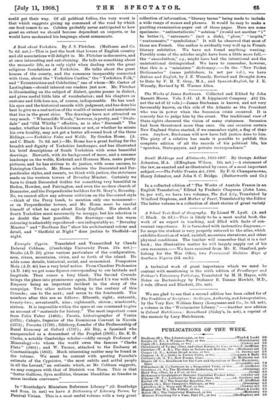Excerpta Cypria. Translated and Transcribed by Claude Delaval Cobham. (Cambridge
University Press. 21s, net.)— Strabo (A.D. 26) gives various particulars of the configuration, area, rivers, mountains, cities, and so forth of the island. He adds some details, historical, social, and economical. Pomponius Mela (A.D. 40) has a very brief notice. From Claudius Ptolemaios (A.D. 140) we get some figures corresponding to our latitude and longitude. Then comes a long blank. The Second Crusade brings the place into prominence again, Richard L's war with the Emperor being an important incident in the story of the campaign. Two other notices belong to the century of this Crusade ; one to the next ; and seven to the fourteenth. The numbers after this are as follows : fifteenth, eight ; sixteenth, twenty-two ; seventeenth, nine; eighteenth, eleven ; nineteenth, sixteen. It is impossible within the space at our command to give an account of "materials for history." The most important come from Felix Faber (1483) ; Paruta, historiographer of Venice (1570) ; Calepio, Superior of the Dominican Convent in Nicosia (1573) ; Pococke (1738) ; Sibthorp, founder of the Professorship of Rural Economy at Oxford (1787) ; Ali Bey, a Spaniard who masqueraded as a descendant of the Prophet (1806) ; Dr. E. D. Clarke, a notable Cambridge scholar—oddly enough Professor of Mineralogy—to whom the world owes the famous "Clarke Plato" (1801) ; and W. Turner, attached to the Embassy at Constantinople (1812). Much interesting matter may be found in the volume. We must be content with quoting Pococke's estimate of the Cypriotes, "the most subtle and artful people in all the Levant," an estimate which, as Mr. Cobham suggests, we may compare with that of Dietrich von Niem. This is that "fastus Gallicus, Syra moflities, Graecae blanditiae ac fraudes in nnam insulam convenere."






































 Previous page
Previous page